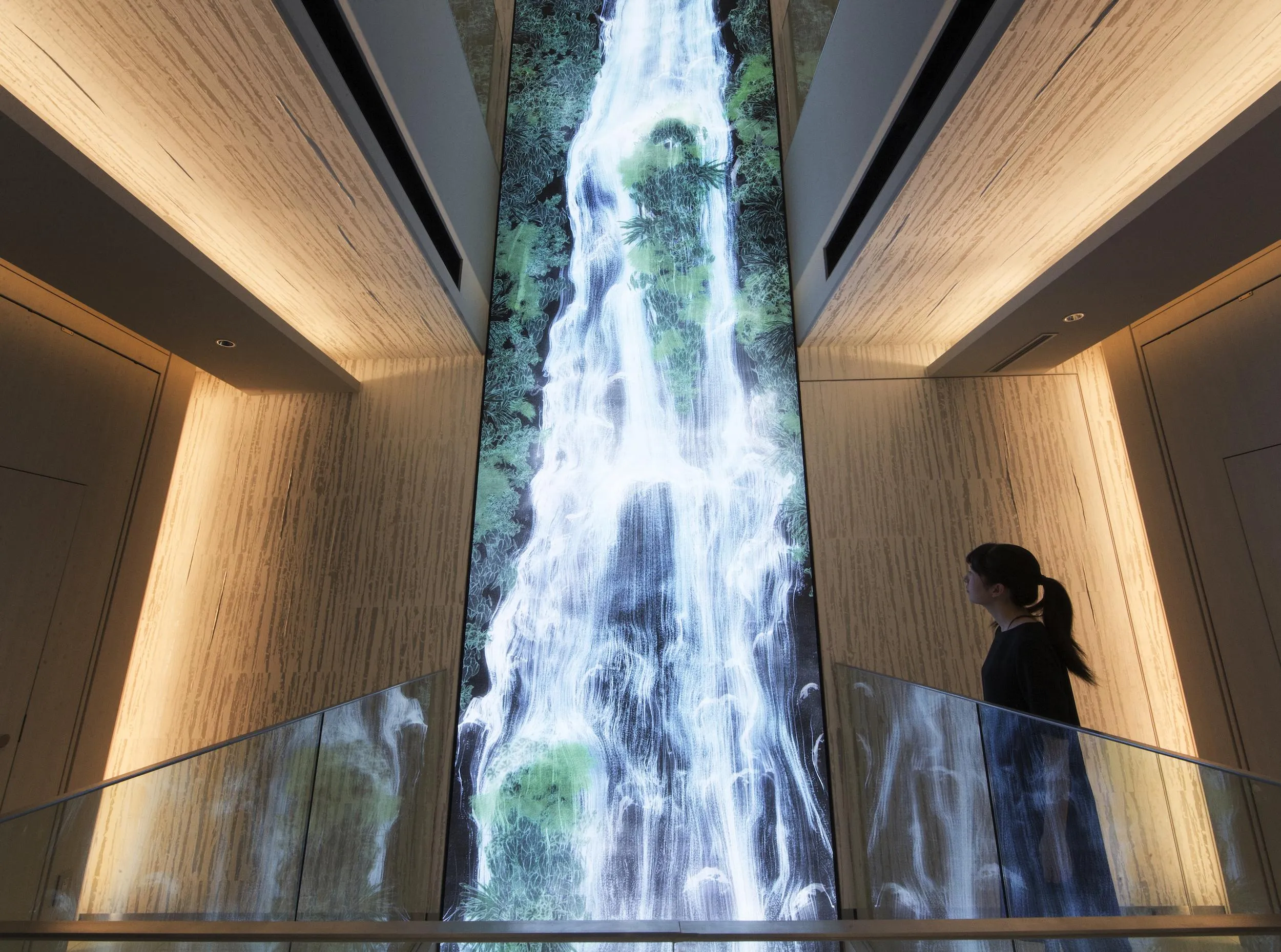
الحياة نشأت من خطوط
2013
المدى الذي يمكن أن تراه العين البشرية في أي لحظة ضيق وذو نطاق تركيز ضحل. ويمكن القول إننا نرى الفضاء من خلال إعادة بناء مجموعات من الصور الضيقة والضحلة وثنائية الأبعاد لأجزاء من فضاء يعود إلى وقت ما في الماضي. لذلك، فإنّ الفضاء الذي نراه من خلال أجسامنا هو إعادة بناء لمجموعة من أجزاء أكبر بكثير من الأجزاء التي نراها عندما نرصد الفضاء بأكمله من خلال عدسة الكاميرا. وفي مثل هذه الأجزاء المتراكمة يتم احتواء مفهوم الوقت.
وكما تمّ توضيحه في تفاصيل الفضاء فوق الذاتي، فإنّ العودة إلى وقت سابق لدمج وإعادة بناء الصورة مع الفضاء فوق الذاتي قد يستغرق وقتًا أطول. كذلك، يعتقد تيم لاب أنّ إدراك كل لحظة، في الماضي، كان يستغرق وقتًا أطول مقارنة بالوقت الحاضر. وربما يفسّر ذلك لماذا كان فنانو "أوكيو إي" في عهد "إيدو" يرسمون المطر من خلال خطوط في القرن الثامن عشر (الرسم1)، مثل الخطوط التي رسمها "أوتاغاوا هيروشيغي" لتصوير المطر في عمل "أمطار مفاجئة على جسر شين أوهاشي وأتاكيه" (1857) (الرسم 2). وخلال تلك الفترة، لم يصوّر الفنانون الأوروبيون المطر بهذه الطريقة (الرسم 3)، ومع ذلك، اختار فنسنت فان غوخ نسخ تقنية الأمطار المفاجئة على جسر شين أوهاشي وأتاكيه في أحد أعماله الفنية (الرسم 4).
وفي الفن الشرق آسيوي خلال عصر ما قبل الحداثة، غالبًا ما كان يتم تصوير الماء، مثل الأنهار والمحيطات، على أنه مجموعة من الخطوط (الرسم 5، الرسم 6)، وهذه المجموعة من الخطوط كانت تعبّر عن الحياة، كما لو كان الماء كيانًا حيًا.
وعندما يتم النظر إلى الجسيمات التي تشكّل الماء على مدى فترة زمنية أطول، تولّد حركات الجسيمات الفيزيائية الخطوط. وفي تلك اللحظة، يصبح الماء السائل، وهو سلسلة متّصلة من الجسيمات، مجموعة من الخطوط المرسومة في فضاء ثلاثي الأبعاد. وعندما تُترجم هذه المجموعة من الخطوط إلى فضاء ثنائي الأبعاد عبر الفضاء فوق الذاتي، تختفي الحدود بين المشاهد وعالم العمل الفني، وقد يشعر المشاهد حتّى أنّه جزء من تلك المجموعة من الخطوط، وقد يبدأ في الشعور بالحياة داخلها.
FEATURED WORKS
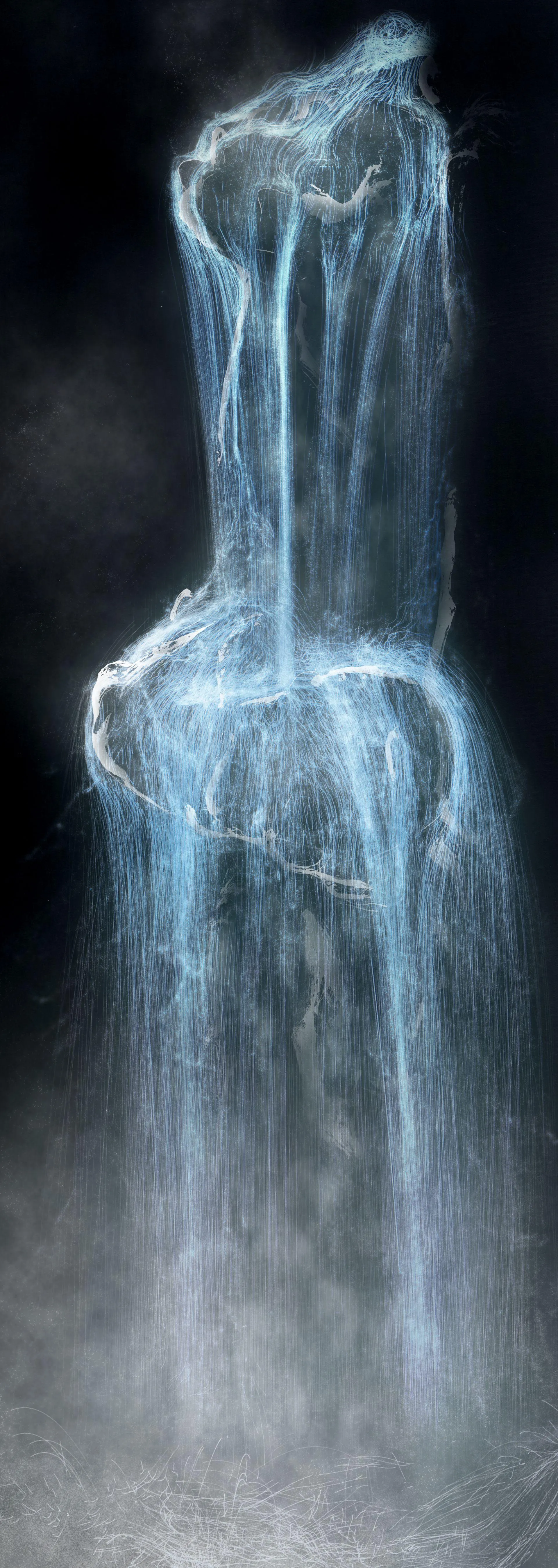
teamLab, 2013, Digital Work, 5 channels, Continuous Loop
Computer-generated water consisting of hundreds of thousands of water particles is virtually poured onto a virtually sculpted rock. The computer calculates the movement of the particles to produce a simulation of water that flows in accordance with the laws of physics. Lines are drawn in relation to a selection of 0.1% of the particles. The sinuousness of the lines depends on the overall interaction of the water particles.
In premodern Japanese painting, oceans, rivers, and other bodies of water were expressed using a series of lines. These lines give the impression of movement and life, as though water was a living entity. This form of expression leads us to explore why premodern people sensed life in rivers and oceans. Universe of Water Particles fuses the objective world of today’s knowledge with the subjective world of premodern people.
When viewing this artwork, regardless of the fact that the waterfall is a reproduction of physical phenomena, it can be possible to feel a sense of life in the collection of lines.
If, when viewing this artwork—as opposed to a video of a waterfall shot with a video camera—people feel the barrier between themselves and the waterfall dissolve, they become immersed in the work as if the waterfall is luring them in. Perhaps we can find a connection to the way premodern Japanese people perceived the world and consequently behaved towards it.
If we regard ourselves as part of nature, and consider nature as something not just to be observed, it is possible to feel that there is no boundary between ourselves and nature.
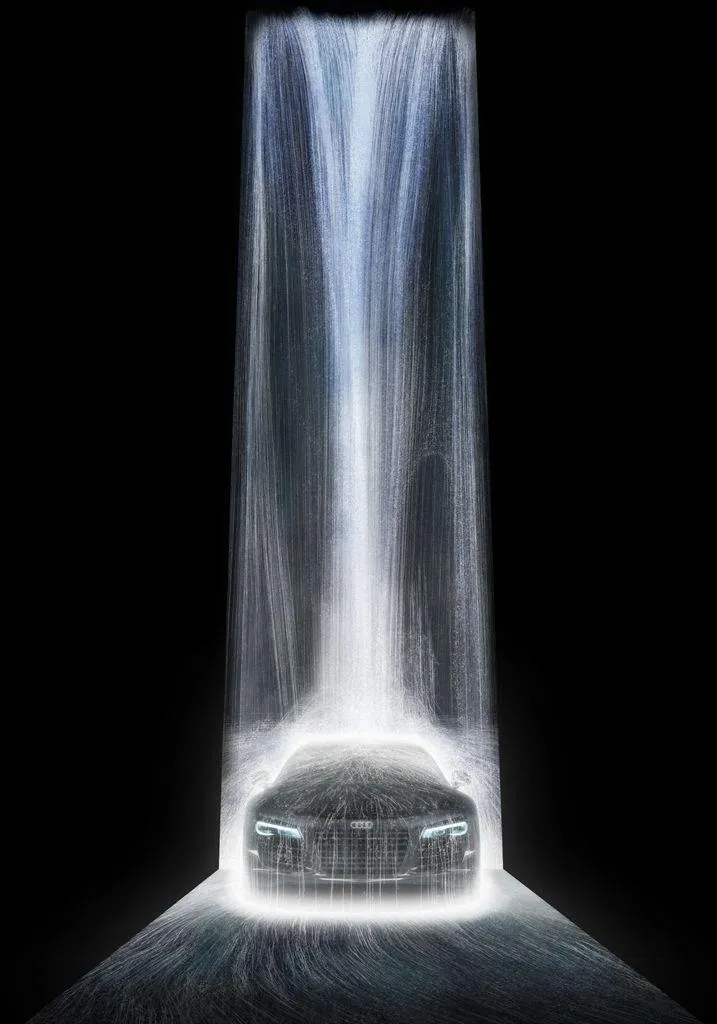
teamLab, 2013, Installation, 4 min, H: 16000mm
Projection mapping of a waterfall simulation onto an Audi R8. The simulation of the waterfall was created by calculating the movement of water as it was allowed to fall on a 3-D model of an Audi R8 in a virtual computer environment. With the R8 like a rock, the waterfall simulation is projected onto a real R8 for this projection mapping artwork.
The artwork is created by same process as Universe of Water Particles.

teamLab, 2018, Digital Installation, Continuous Loop
The large exhibit space at Amos Rex is characterized by its distinctly curved ceiling, which becomes a part of the plaza landscape above ground. The large skylight at the top of the space connects the exhibit underground with the plaza above.
From the underground exhibit space, water pours up to the ceiling, towards the skylight and the outside world. The water is represented by a continuum of numerous water particles, and the interaction between the particles is calculated. Lines are drawn in relation to the behavior of the water particles. The lines are then “flattened” using what teamLab considers to be ultrasubjective space. The movement of water is determined by the shape of the museum and the force that pulls the water up to the skylight and the plaza above ground. It is this movement of water that creates the installation.
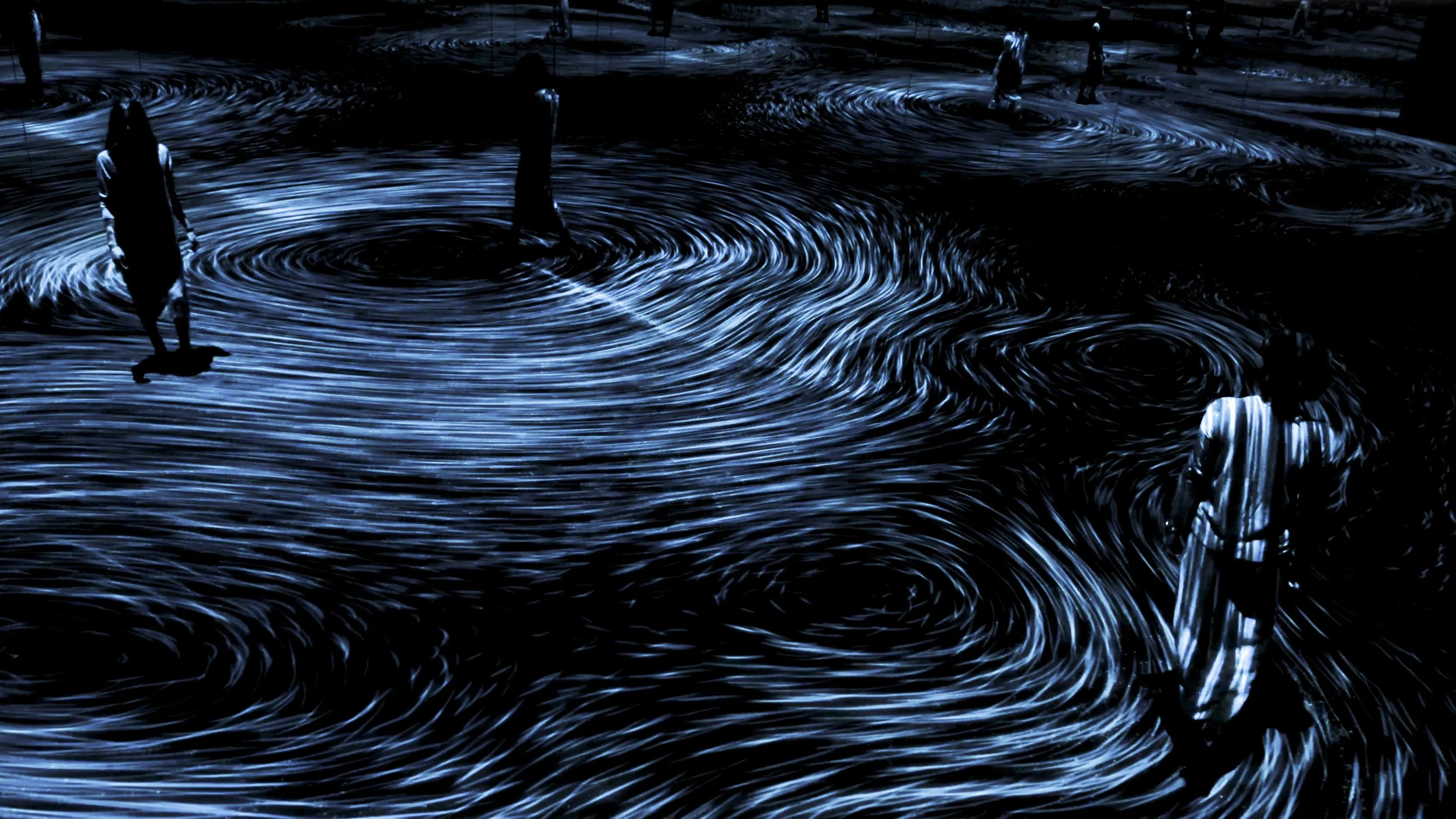
الحركة تخلق دوامات والدوامات تخلق حركة
teamLab, 2017-, Interactive Digital Installation, Endless, Sound: teamLab
عندما يتحرك شخص ما، يتولد تدفق، وهذا التدفق يخلق تأثيرًا يمتد بعيدًا وعلى نطاق واسع. ستخلق حركة الأشخاص الآخرين بالمثل تدفقًا، وستجتمع التدفقات معًا وتشكل دوامة.
عندما يتوقف الأشخاص، أو إذا غادر الأشخاص المكان، سيختفي التدفق في النهاية ولن يبقى شيء في المكان.
يُعبِّر التدفق في العمل الفني عن استمرارية الجزيئات، وتُرسم الخطوط في الفضاء ثلاثي الأبعاد وفقًا لمسارات تلك الجزيئات. ويتم بعد ذلك تسطيح تراكم الخطوط التي تمثل العمل وفقًا لما يسميه تيم لاب "الفضاء فوق الذاتي".
تصدر كل جزيئة نغمة قصيرة للغاية عندما تتحرك. ومن خلال حركة العديد من الجزيئات، تتحول النغمات إلى موسيقى متواصلة.
تم طلب هذا العمل الفني من قبل المعرض الوطني لفنون فيكتوريا وهو جزء من مجموعته الدائمة. وتم عرضه أيضًا في المعرض NGV الأول الذي يُقام كل ثلاث سنوات (2017-2018).
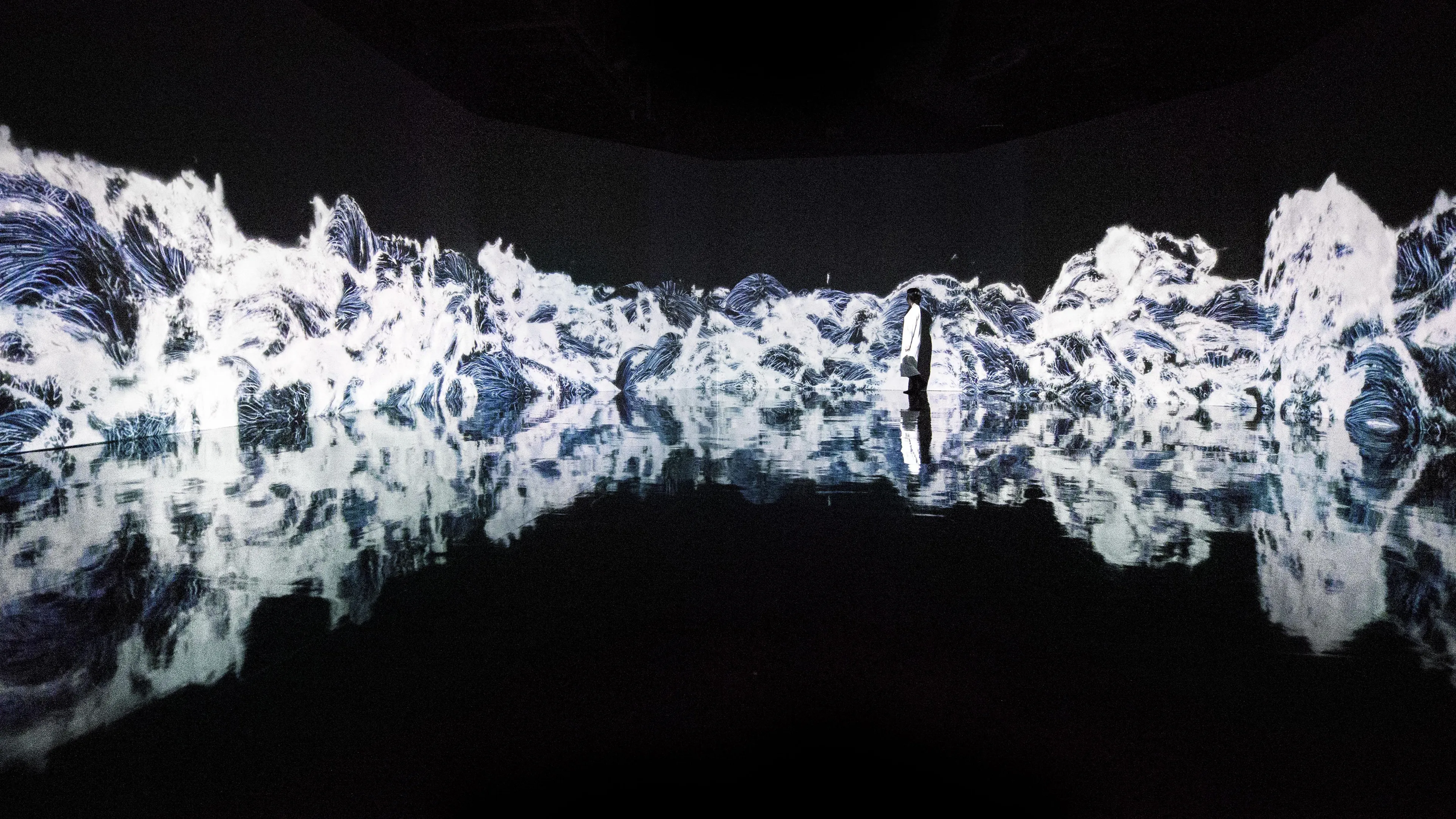
teamLab, 2016, Digital Installation, Continuous Loop, Sound: Hideaki Takahashi
In classical East Asian art, waves are often expressed using a combination of lines. These waves created by lines allow us to realize that each wave is one part of a larger flow, and conveys life as though the waves are a living entity.
When the waves rise, we can feel a powerful breath of life, as though life is blooming. It feels as though each wave has a life of its own. But when the waves collapse and disappear, we realize, with a sense of fragility, that they were a part of the ocean. And that ocean is connected to all of the other oceans. In other words, all of the waves in the world are connected to each other.
The waves seem alive because life is like a rising wave. It is a miraculous phenomenon that continuously emerges from a single, continuous ocean.
The waves are expressed through a continuous body of countless water particles. The interactions of particles are calculated, and then the movement of water is simulated in three-dimensional space. Lines are created along the trajectories of the water particles, and drawn on the surface layer of the three-dimensional waves.
The lines are created with what teamLab refers to as Ultrasubjective Space. In contrast to space that is created through, or cut out by, lenses and perspective, Ultrasubjective Space does not fix the viewer’s viewpoint and in turn frees the body. The wall that the waves are seen on does not become a boundary between the viewer and the artwork, and the artwork space is continuous with the space of the viewer’s body.
